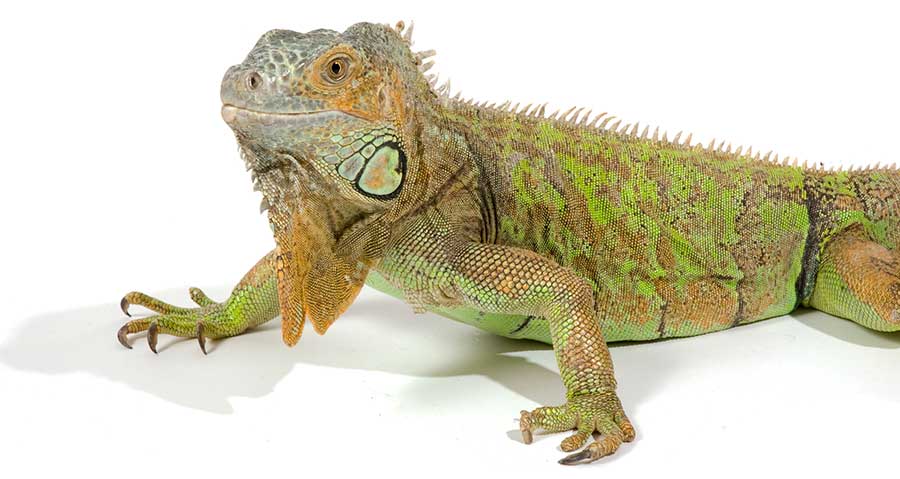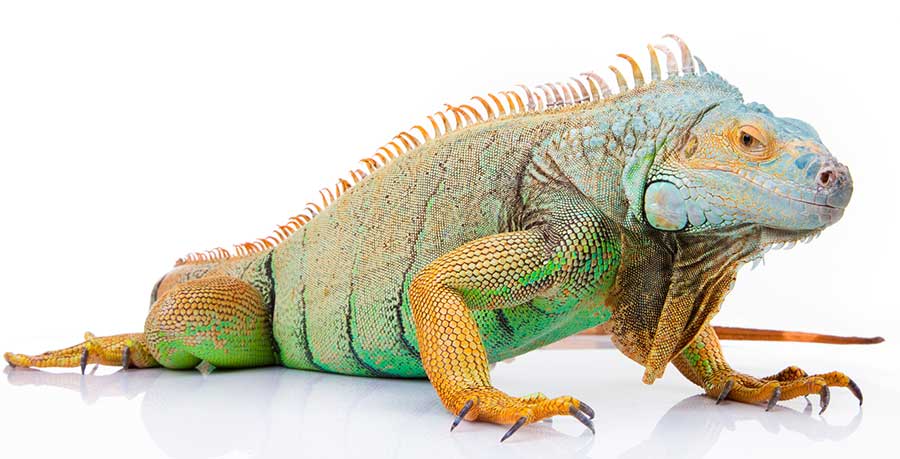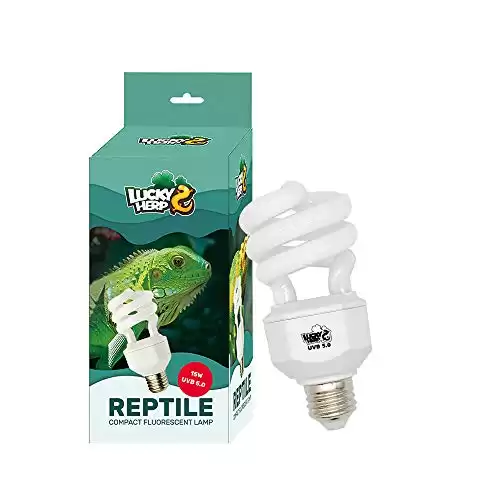Male vs female iguanas — how can you tell the difference between male and female iguanas?
Fortunately, it’s actually fairly easy to learn how to sex an iguana, as they are sexually dimorphic. This means there are several key physical differences between the males and females of the species.
However, this does mean you’ll need to wait until your iguana is sexually mature in order to definitively tell whether it is a male or a female.
Green iguanas (also known as the common iguana or Iguana Iguana), is the most common species kept as pets, and reaches sexual maturity between 1 and 4 years of age.
If you need to know the difference even sooner, you can take your iguana to your reptile veterinarian for them to do an examination and determine whether your iggy has hemipenes or not.
Otherwise, read on to learn more about sexing iguanas!
Male vs Female Iguanas: 5 Key Differences
Look out for these distinct characteristics to tell the difference between iguana males vs females:
- Size and Weight: Male iguanas are much bigger and heavier, whereas female iguanas are lighter and generally smaller than males.
- Jowls and Dewlap: Male iguanas have huge jowls and a pronounced dewlap, whereas females have small jowls and a barely present dewlap.
- Femoral pores and Hemipenal Bulges: Male iguanas have large femoral pores and hemipenal bulges, whereas female iguanas do not have enlarged femoral pores or hemipenes.
- Reproduction: Male iguanas do not lay eggs, whereas female iguanas will lay eggs even if they have not mated.
- Spikes: Male iguanas have large dorsal and vertebral spines, whereas females’ spikes are much smaller and less pronounced.
If you’re wondering whether you should adopt a male or female iguana, neither sex is significantly better or worse to own in terms of temperament or ability.
Whether you should have a male or a female iguana will mostly come down to the amount of space you have available and how many other iguanas you have. Both sexes need a lot of space so bear that in mind before adopting one!
Males are much larger than females and will require a larger enclosure. The entire enclosure will need to be higher, longer, and wider to house a male. However, females will need to have a burrowing box or section of their enclosure which they can dig in and not be able to escape.

It is important to know how to tell the difference between male and female iguanas so you can prepare your iggy’s enclosure appropriately for the future.
Read on to find out exactly how to tell the difference between male and female iguanas.
How to Sex Your Iguana
Male iguanas have certain features and physical traits which make them easy to identify against a female iguana. Remember that these physical characteristics will only become apparent once your pet iguana has reached sexual maturity.
Overall Size
Male iguanas can get up to eight feet in length and can weigh over 20 pounds! However, female iguanas will rarely exceed six feet in length and typically max out at around 6 to 10 pounds. Both male and female iguanas are very large lizards so they are not a good choice for beginner reptile owners.
The first difference you’ll probably notice is that males have much broader and heavier bodies with thicker, more powerful tails. Females, on the other hand, have much slimmer, narrower bodies and have thinner, more whip-like tails.
In addition to this, male iguanas have very broad and powerful chests, which means they also stand taller than the females.
Below is an approximate growth chart for male and female iguanas. You can see that during their early years, male and female growth is pretty much the same. During their first couple of years of life, they are not yet fully sexually mature, which means the more obvious size and feature differences have not yet appeared.
Keep in mind that the lengths listed are measured from the iguana’s snout to tail tip.
Male Iguana Growth Rate
Once green iguanas become sexually mature, there is a very distinct size difference both in length and in weight.
Female Iguana Growth Rate
The following chart shows the growth rate of female iguanas, along with the size of enclosure they should ideally be housed in.
Head Shape, Size, and Features
Aside from their weight and length, male and female green iguanas have several differences when it comes to the shape and size of their heads. Below I’ve listed the most obvious differences between the two sexes.
Bumps
Male iguanas have small bumps on top of their heads just behind their eyes. These bumps become more pronounced the older the iguana gets.
These bumps are missing on female iguanas. The lack of these bumps makes the female iguana’s head look much slimmer and smoother than those of the males.
Dewlaps
Male iguanas have very large dewlaps under their chins. These prominent dewlaps are large flaps of skin that are meant to look scary and impressive and set alpha males apart from the rest. Male iguanas with larger dewlaps typically attract more females during mating season.
Female iguanas, on the other hand, have very small dewlaps. Sometimes, these dewlaps are not even present, particularly on very small or young females.
Jowls
Male iguanas have very powerful jaws. Their jaws get their power from the incredibly large muscles on either side of their face. These very large muscles make it look like the males have huge, bulging jowls.
On the other hand, females do not have facial muscles that are quite as large as the males’. This also means their ‘jowls’ are not nearly as large and that a female iggy’s bite will not be as painful or damaging as a male’s.
Enlarged Disks
Both male and female iguanas have enlarged disk-like scales on either side of their heads.
Male iguanas’ disks are typically much larger than the females’ and will be darker in color or have a green, almost black ring around them.
Female iguanas also have these enlarged disk-like scales on either side of their heads. However, these disks are smaller and not deeply colored or ringed in a dark green/black color.
Spikes
Another key difference between males and females is the size of their spikes.
Male adult iguanas have elongated dorsal spikes that run along their spines. These spikes will start at the tip of their tail and run all the way up to their heads. Males will have smaller spikes along their chins, too! A male iggy’s spines are very tough, long, and distinct.
Female iguanas do have dorsal spines that run along their spines; however, these spikes are much smaller than the males’ ones. In general, they are shorter, thinner, and softer. The female’s spikes run from the tip of their tails to the base of their necks. Females do not typically have spikes on the tops of their heads. They do, however, occasionally have short spikes under their chins.
Juvenile iguanas will have soft dorsal spines from a very young age, so using their spikes to determine sex is not reliable until they are about 3 to 4 years old.
Genitals
Another key difference between sexually mature male and female iguanas is their genitals. Below are the two main differences that become apparent once a green iguana reaches adulthood.
Femoral Pores
Male iguanas have distinct femoral pores. These look like large, pale scales on the inside of their thighs on their hind limbs. The femoral pores enlarge during mating season and secrete a waxy substance that contains pheromones that attract potential female mates.
Female iguanas, as you’d imagine, do not have pronounced femoral pores. This is simply because they do not have a need for them. When looking at the hind legs of a sexually mature iguana, it is very easy to see the difference between males and females.
Hemipenal Bulges
At the base of a male iguana’s tail where it meets the lizard’s body, there are two distinct bulges. These bulges contain the hemipenes. As a reptile with a tail, iguanas have two penises to facilitate sexual reproduction.
Females do not have these bulges because they do not have hemipenes.
Do not probe the cloaca to determine the sex as you would a snake. If you are not an expert at “expressing” an iguana’s hemipenes, you can severely injure your animal and stress them out significantly.
However, if you want or need to know what sex your iguana is before they are sexually mature and the seller is unable to tell you, then take your iguana to an exotic veterinarian to get them to determine the sex.
Egg Laying
Another fairly obvious difference between male and female iguanas is that females lay eggs. Male iguanas do not lay eggs at all. If your iguana suddenly lays an egg or two, you can be assured it is a female.
Notably, female iguanas will occasionally develop and lay eggs without ever coming into contact with a male. This is just part of their natural cycle. They will also exhibit burrowing and nesting behavior during laying times and breeding season.
This means that, in terms of husbandry, females will need a section of their enclosure that is safe to dig in.
It is also worth mentioning that developing and laying eggs uses up a huge amount of energy. Female iguanas will use their energy reserves to produce eggs over maintaining their own bodies. This is one reason why females do not always live as long as males.
All iguanas need a
Male iguanas may also benefit from
Learn more about what iguanas eat.

Sex-Specific Health Problems
Green iguanas are wonderful animals but they are not great beginner lizards. They require huge enclosures and they are also susceptible to certain health problems.
Male and female iguanas can both suffer from malnutrition, a lack of UVB lighting (vitamin D absorption), and metabolic bone disease. These are all things that can be rectified through their diet and an adjustment of their enclosure settings.
In addition, both male and female iguanas can suffer from internal and external parasites. This is usually the case when your iguana is wild-caught or is farm-raised. A simple trip to the vet can help rectify parasite problems.
There is, however, one health condition that only affects female iguanas and not males: that is becoming egg bound, also known as dystocia. If for some reason a female is unable to lay an egg, it will become stuck inside of her.
Being egg-bound is incredibly painful for an iguana. It can lead to decreased fertility in the future and even death if not treated promptly.
Iguanas affected by dystocia need urgent vet attention to resolve the problem. A female iguana becoming egg-bound is very rare. However, if it does happen, it is usually because something is wrong with her care. For example, she might be dehydrated or too cold, not have enough space to exercise and move, or not have a proper nesting box.
Be sure to follow your reptile vet’s instructions in order to solve the issue. In mild cases, fixing what is wrong with the husbandry will resolve the problem very quickly. In more severe cases, the female iguana will need to undergo surgery to get the stuck egg removed.
Equipment for Males vs Females Iguanas
As we’ve discussed, there are a lot of similarities between looking after male and female iguanas, however there are a few differences that are important to note when it comes to equipment.
Here’s a reminder of the setup you need for male and female iguanas to make sure they are happy and healthy.
Male Iguana | Female Iguana | |
Enclosure Size | Up to 6ft x 9ft (depending on size of iguana) | Up to 5ft x 7ft (depending on size of iguana) |
Enclosure Setup | 5.0 UV bulb Heat emitting bulb/heat mat Foliage and vines Climbing branches Food bowl
Large water bowl | 5.0 UV bulb Heat emitting bulb/heat mat Foliage and vines Climbing branches Food bowl
Large water bowl Burrowing box |
Diet | Varied diet consisting of mainly dark green leafy vegetables Small amount of fruit Fresh water | Varied diet consisting of mainly dark green leafy vegetables Small amount of fruit Fresh water + calcium supplement during laying season |
Final Thoughts on Sexing Iguanas
Which sex is better to own: a male or a female iguana? Well, neither sex is objectively better to own as males and females mostly share the same kind of temperament with very few behavioral differences.
Both sexes can be very aggressive if they are not socialized properly from a young age. However, both sexes can also make lovely companions if they receive the proper care.
Adult males are much larger than females and will need larger enclosures, more food, and a stronger set of hands to wrangle when they are in a bad mood.
Females, on the other hand, are smaller, they require less enclosure space, and you can house multiple females together.Whatever you do, don’t underestimate the size of these amazing reptiles.
Neither male or female iguanas should be taken on by anyone who doesn’t have the space and resources to give them the proper care they need. There are lots of smaller reptiles which are more suitable for beginners – have a look at our guide to the best lizards for handling.
FAQs About Male and Female Iguanas
Can I keep multiple female iguanas in the same enclosure?
You can keep multiple female iguanas in the same enclosure. If you are aiming to have an enclosure with multiple females, try and get them all at the same time and at the same age. This will ensure there will not be a new addition to the family that is more dominant than the others.
Always remember that when you add another iguana to an enclosure, you need to increase the size of the enclosure, the amount of vertical climbing space, and the number of water dishes, hides, and basking spots.
Can I keep multiple male iguanas in the same enclosure?
You should not keep multiple male iguanas in the same enclosure. They become territorial and aggressive during mating season and will end up fighting each other (in many cases to the death).
If you feel like adding another iguana to your established male’s enclosure, look for a female around the same age.
Like with female iguanas, always remember that when you add another iguana to an enclosure, you need to increase the size of the enclosure, the amount of vertical climbing space, the number of water dishes, hides, and basking spots.
Are male or female iguanas more aggressive?
Neither sex is more aggressive than the other if they are in the right enclosure and are kept using proper husbandry techniques.
However, males can become territorial and demonstrate aggressive behavior during mating season, especially if there are other males present. This is natural, as in the wild, they need to be more dominant and aggressive than other nearby males so they can mate with all the females without competition.
Females can occasionally be aggressive if they are defending their eggs or their nesting box. In the end, your iguana’s level of aggression comes down to the amount of socializing you have done rather than what sex they are.
Can I pop the hemipenes out to determine sex as you do with snakes?
You should never attempt to ‘pop’ or ‘express’ the hemipenes out of any lizard, including iguanas. This can cause permanent damage to your iguana and also be incredibly painful for them.
Do male or female iguanas live longer?
Male and female iguanas live to be approximately 10 years old in the wild. In captivity, however, they can live for around 20 years with high-quality care! Their lifespans are not sex dependent.
However, if females are not given proper
Chomping Off…
Iguanas are beautiful reptiles regardless of their sex. Learning how to tell if an iguana is male or female is fairly simple because they have such distinct physical differences once they are sexually mature.
However, always check with a veterinarian if you are unsure of the sex as it affects their long term care requirements.



